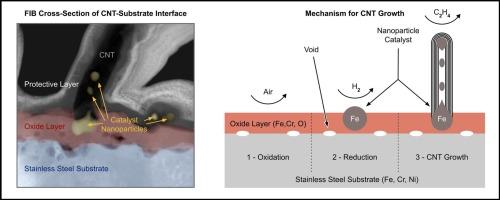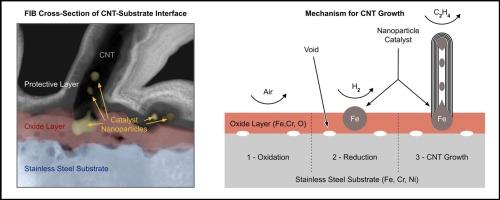Mechanisms for carbon nanotube growth on oxidized 316L stainless steel substrates
IF 6.9
2区 材料科学
Q2 CHEMISTRY, PHYSICAL
引用次数: 0
Abstract
We investigated the growth of carbon nanotubes (CNTs) directly on stainless steel substrates. The CNTs were grown using a two-step process: oxidation of the stainless steel surface and CNT growth. The samples were oxidized in an 800 °C furnace fed with a flow of air for 4 min. CNTs were grown by switching the flow to ethylene, which both reduces the oxide and initializes CNT growth. The time of CNT growth was varied to understand how the samples evolved over time. To better understand the growth mechanisms, we isolated cross-sections of the CNT-substrate interface using a focused ion beam. These cross-sections were investigated with transmission electron microscopy and energy dispersive X-ray spectroscopy. CNTs were seen to grow from iron-rich nanoparticles embedded in the oxide layer. The oxide layer was also seen to lose iron over time, suggesting that these iron nanoparticles were reduced out of the oxide. The base particles were embedded in the oxide layer, leaving cavities when the CNTs were removed. The diameters of the nanotubes were also seen to grow over time as a result of carbon infiltration. The effects of the embedded particle and infiltration quickly isolate the catalyst, leading to short CNTs (1–10 µm).


氧化316L不锈钢基体上碳纳米管生长机理研究
我们研究了碳纳米管(CNTs)在不锈钢衬底上的直接生长。碳纳米管的生长采用两步工艺:不锈钢表面氧化和碳纳米管生长。样品在800 °C的加热炉中以4 min的气流进行氧化。碳纳米管通过切换到乙烯来生长,这既减少了氧化物,又初始化了碳纳米管的生长。碳纳米管生长的时间是不同的,以了解样品如何随着时间的推移而演变。为了更好地理解生长机制,我们使用聚焦离子束分离出cnt -衬底界面的横截面。用透射电子显微镜和能量色散x射线能谱对这些截面进行了研究。可见碳纳米管是从嵌入氧化物层的富铁纳米颗粒中生长出来的。随着时间的推移,氧化层也失去了铁,这表明这些铁纳米颗粒被还原出了氧化物。当碳纳米管被移除时,基颗粒被嵌入到氧化层中,留下空腔。由于碳的渗透,纳米管的直径也随着时间的推移而增长。在颗粒包埋和渗透的作用下,催化剂被快速分离,形成短CNTs(1-10 µm)。
本文章由计算机程序翻译,如有差异,请以英文原文为准。
求助全文
约1分钟内获得全文
求助全文
来源期刊

Applied Surface Science
工程技术-材料科学:膜
CiteScore
12.50
自引率
7.50%
发文量
3393
审稿时长
67 days
期刊介绍:
Applied Surface Science covers topics contributing to a better understanding of surfaces, interfaces, nanostructures and their applications. The journal is concerned with scientific research on the atomic and molecular level of material properties determined with specific surface analytical techniques and/or computational methods, as well as the processing of such structures.
 求助内容:
求助内容: 应助结果提醒方式:
应助结果提醒方式:


